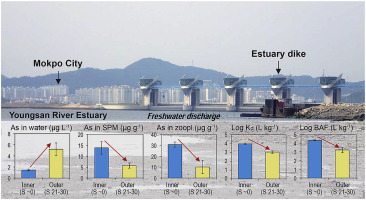Environmental Pollution ( IF 7.6 ) Pub Date : 2017-11-13 , DOI: 10.1016/j.envpol.2017.11.020 Seongjin Hong , Sung-Deuk Choi , Jong Seong Khim

|
Differences in the distribution, partitioning, and bioaccumulation characteristics of arsenicals between freshwater and saltwater systems remain poorly understood. To determine the characteristics of distribution and behavior of arsenicals, multimedia environmental samples including water, suspended particles, zooplankton, sediments, and porewater were collected from inner (five sites, freshwater) and outer (five sites, saltwater) regions of the estuary dike of the Youngsan River Estuary in South Korea (Nov., 2012). Six organic and inorganic forms of As were separated and measured using HPLC–ICP/MS equipped with an anion exchange column. Concentrations of arsenicals in water samples of the inner region (mean = 1.5 μg As L−1) were significantly lower than in those of the outer region (mean = 5.2 μg As L−1). Conversely, concentrations of As in suspended particles in the inner region (mean = 14 μg As g−1) were much greater than in the outer region (mean = 5.7 μg As g−1). The field-based distribution coefficient (Kd) for As depended strongly on salinity; relatively greater Kd values were found in freshwater compared with saltwater. The AsV was found to be the major form of As in all water and particle samples in both inner and outer regions. The zooplankton species were significantly distinguishable between the inner and outer regions; cladocerans were the most dominant species in freshwater and cyclopoida were predominantly found in saltwater. The As concentrations in zooplankton were shown to be particle-concentration dependent, suggesting that dietary exposure plays a substantial role in the bioaccumulation of As. Inorganic arsenicals, such as AsV and AsIII were the most dominant forms found in zooplankton. Partitioning behavior of As between porewater and sediments was similar to that in water–particle distributions. The results of the present study enhance the understanding of As biogeochemistry in river and estuarine environments.
中文翻译:

韩国Youngsan河口环境多媒体样品中的砷形态:淡水和盐水之间的比较
淡水和盐水系统之间砷的分布,分配和生物蓄积特性的差异仍然知之甚少。为了确定砷的分布和行为特征,从河口堤防的内部(五个地点,淡水)和外部(五个地点,咸水)区域收集了包括水,悬浮颗粒,浮游动物,沉积物和孔隙水在内的多媒体环境样品。韩国的Youngsan河口(2012年11月)。使用配备阴离子交换柱的HPLC-ICP / MS分离并测量了六种有机和无机形式的砷。内部区域(平均= 1.5μgAs L -1)的水样中的砷含量明显低于外部区域(平均= 5.2μgAs L)的砷浓度-1)。相反,内部区域中的悬浮颗粒中的As浓度(平均值= 14μgAs g -1)比外部区域中的As浓度高(平均值= 5.7μgAs g -1)。砷的基于场的分布系数(K d)在很大程度上取决于盐度。与盐水相比,在淡水中发现的K d值相对较高。在作为V被发现是内部和外部区域所有水和颗粒样品中砷的主要形式。浮游动物种类在内部区域和外部区域之间是明显可区分的。枝角类是淡水中最主要的种类,而环孢菌主要在盐水中发现。浮游动物中的砷浓度显示出与颗粒物浓度有关,这表明饮食暴露在砷的生物蓄积中起着重要作用。无机砷,如As V和As III是浮游动物中最主要的形式。砷在孔隙水和沉积物之间的分配行为与水-颗粒分布中的分配行为相似。本研究的结果增强了对河流和河口环境中砷生物地球化学的认识。











































 京公网安备 11010802027423号
京公网安备 11010802027423号